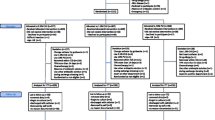Abstract
Objective
To explore the preventive effect of applying hot compress with Chinese herbal salt packets (CHSP) to puncture vessels under aseptic conditions during peripherally inserted central catheter (PICC) on postoperative phlebitis.
Methods
A total of 720 hospitalized patients undergoing first PICC were assigned to treatment and control groups (360 cases each group) according to a random number table. The control group received conventional catheterization and nursing care. The treatment group was first given hot compress with CHSP (which consisted of honeysuckle 30 g, Semen brassicae 30 g, Salvia miltiorrhiza 30 g, Angelica dahurica 30 g, Semen raphani 30 g, Evodia rutaecarpa 30 g, and coarse salt 20 g) on the punctured vessel under aseptic conditions for 5–10 min before conventional catheterization. The main efficacy indices were the vessel diameters before and during catheterization and the success rate of a single catheter, and the secondary efficacy indiex was the incidence of superficial phlebitis within 1 week after catheterization.
Results
The vessel diameter during catheterization of the treatment group was remarkably increased compared with the control group [(7.96±0.42) mm vs. (4.39±0.54) mm, P<0.01]. The success rate of the single catheter of the treatment group was significantly higher than that of the control group [94.00% (329/350) vs. 73.72% (244/329), P<0.01]. The incidence of superficial phlebitis within 1 week after catheterization in the treatment group was lower than that in the control group (P=0.007). There was no adverse event with CHSP.
Conclusion
Hot compress with CHSP during PICC is applicable as it can effectively improve the success rate of a single catheter and reduce the incidence of superficial phlebitis after catheterization (Trial registration No. ChiCTR-ONC-17010498).
Similar content being viewed by others
References
Bertoglio S, Faccini B, Lalli L, Cafiero F, Bruzzi P. Peripherally inserted central catheters (PICCs) in cancer patients under chemotherapy: a prospective study on the incidence of complications and overall failures. J Surg Oncol 2016;113:708–714.
Poli P, Scocca A, Di Puccio F, Gallone G, Angelini L, Calabro EM. A comparative study on the mechanical behavior of polyurethane PICCs. J Vasc Access 2016;17:175–181.
Lefebvre L, Noyon E, Georgescu D, Proust V, Alexandru C, Leheurteur M, et al. Port catheter versus peripherally inserted central catheter for postoperative chemotherapy in early breast cancer: a retrospective analysis of 448 patients. Support Care Cancer 2016;24:1397–1403.
Martella F, Salutari V, Marchetti C, Pisano C, Di Napoli M, Pietta F, et al. A retrospective analysis of trabectedin infusion by peripherally inserted central venous catheters: a multicentric Italian experience. Anticancer Drugs 2015;26:990–994.
Fadoo Z, Nisar MI, Iftikhar R, Ali S, Mushtaq N, Sayani R. Peripherally inserted central venous catheters in pediatric hematology/oncology patients in tertiary care setting: a developing country experience. J Pediatr Hematol Oncol 2015;37:e421–e423.
Valbousquet Schneider L Jr, Duron S, Arnaud FX, Bousquet A, Kervella Y, Bouzad C, et al. Evaluation of PICC complications in orthopedic inpatients with bone infection for long-term intravenous antibiotics therapy. J Vasc Access 2015;16:299–308.
Franceschi AT, da Cunha ML. Adverse events related to the use of central venous catheters in hospitalized newborns. Rev Lat Am Enfermagem 2010;18:196–202.
Parikh M, Wong M, Farrimond J. An unknown complication of peripherally inserted central venous catheter in a patient with ventricular assist device. Ann Card Anaesth 2011;14:119–121.
Sharp R, Grech C, Fielder A, Mikocka-Walus A, Cummings M, Esterman A. The patient experience of a peripherally inserted central catheter (PICC): a qualitative descriptive study. Contemp Nurse 2014;48:26–35.
Falkowski A. Improving the PICC insertion process. Nursing 2006;36:26–27.
Xiang M, Li N, Yi L, Liu B. Causes and nursing countermeasures in pediatric PICC catheter complications. Pak J Pharm Sci 2016;29:335–337.
Hou CR, Tsai LC, Cheng KF, Chung KC, Hong CZ. Immediate effects of various physical therapeutic modalities on cervical myofascial pain and trigger-point sensitivity. Arch Phys Med Rehabil 2002;83:1406–1414.
Liu ZY, Liu BG, Lin X. Kinematic effect of Chinese herbal fomentation on patients with chronic neck pain. Chin J Integr Med 2014;20:917–922.
Chen GY, Wang HQ, Lin DN. Dipping the catheters in dexamethasone solution to prevent PICC-associated phlebitis. Chin J Nurs (Chin) 2012;47:6–9.
Gorski LA. The 2016 infusion therapy standards of practice. Home Health Now 2017;35:10–18.
Pasalioglu KB, Kaya H. Catheter indwell time and phlebitis development during peripheral intravenous catheter administration. Pak J Med Sci 2014;30:725–730.
Loewenthal MR, Dobson PM, Starkey RE, Dagg SA, Petersen A, Boyle MJ. The peripherally inserted central catheter (PICC): a prospective study of its natural history after cubital fossa insertion. Anaesth Intensive Care 2002;30:21–24.
Cai Y, Hong J. Herbal umbilicus therapy plus hot compress with salt packet for 20 cases of malignant ascites. Chin Acupunct Moxibust (Chin) 2016;36:497–498.
Miyajima R, Kawazoe H, Tsuneoka K, Fujiwara M, Kojima Y, Yakushijin Y. Preventive trial of preheating administration of oxaliplatin-diluted solution in combination with a hot compress for oxaliplatin-induced venous pain. Jap J Cancer Chemother Online 2013;40:537–540.
Author information
Authors and Affiliations
Corresponding author
Additional information
Supported by the Zhejiang Science and Technology Program of Traditional Chinese Medicine (No. 2015ZB043, 2015ZA072), and the Zhejiang Provincial Program for the Cultivation of High-Level Innovative Health Talents (No. 2014-108)
Rights and permissions
About this article
Cite this article
Wu, Xf., Yu, Yj., Ying, Lm. et al. Hot Compress with Chinese Herbal Salt Packets Reducing PICC Catheter Complications: A Randomized Controlled Trial. Chin. J. Integr. Med. 24, 809–814 (2018). https://doi.org/10.1007/s11655-018-2913-y
Accepted:
Published:
Issue Date:
DOI: https://doi.org/10.1007/s11655-018-2913-y




